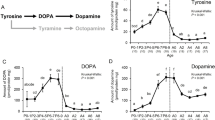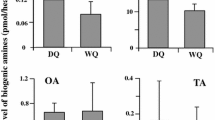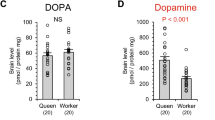Abstract
To explore neuro-endocrinal changes in the brain of European honeybee (Apis mellifera) queens before and after mating, we measured the amount of several biogenic amines, including dopamine and its metabolite in the brain of 6- and 12-day-old virgins and 12-day-old mated queens. Twelve-day-old mated queens showed significantly lower amounts of dopamine and its metabolite (N-acetyldopamine) than both 6- and 12-day-old virgin queens, whereas significant differences in the amounts of these amines were not detected between 6- and 12-day-old virgin queens. These results are explained by down-regulation of both synthesis and secretion of brain dopamine after mating. It is speculated that higher amounts of brain dopamine in virgin queens might be involved in activation of ovarian follicles arrested in previtellogenic stages, as well as regulation of their characteristic behaviors.

Similar content being viewed by others
References
Bailey L (1952) The action of the proventriculus of the worker honeybee, Apis mellifera L. J Exp Biol 29:310–327
Brandes C, Sugawa M, Menzel R (1990) High-performance liquid chromatography (HPLC) measurement of catecholamines in single honeybee brains reveals caste-specific differences between worker bees and queens in Apis mellifera. Comp Biochem Physiol 97C:53–57
Crane E (1990) Bees and beekeeping. Cornel University Press, Ithaca, New York
Dombroski TCD, Simoes ZLP, Bitondi MMG (2003) Dietary dopamine causes ovary activation in queenless Apis mellifera workers. Apidologie 34:281–289
Evans PD (1980) Biogenic amines in the insect nervous system. Adv Insect Physiol 15:356–389
Fahrbach SE, Giray T, Robinson GE (1995) Volume changes in the mushroom bodies of adult honey bee queens. Neurobiol Learn Memory 63:181–191
Gilley DC (2001) The behavior of honey bees (Apis mellifera ligustica) during queen duels. Ethology 107:601–622
Harano K, Obara Y (2004a) Virgin queens selectively destroy fully matured queen cells in the honeybee Apis mellifera L. Insectes Soc 51:253–258
Harano K, Obara Y (2004b) The role of chemical and acoustical stimuli in selective queen cell destruction by virgin queens of the honeybee Apis mellifera. Appl Entmol Zool 39:611–616
Harris JW, Woodring J (1995) Elevated brain dopamine levels associated with ovary development in queenless worker honey bees (Apis mellifera L.). Comp Biochem Physiol 111C:271–279
Harris JW, Woodring J, Harbo JR (1996) Effects of carbon dioxide on levels of biogenic amines in the brains of queenless worker and virgin queen honey bees (Apis mellifera). J Apic Res 35:69–78
Kaftanoglu O, Peng Y (1982) Effects of insemination on the initiation of oviposition in the queen honeybee. J Apic Res 21:3–6
Laidlaw HH, Page RE (1997) Queen rearing and bee breeding. Wicwas press, Cheshire, Connecticut, USA
Menzel R, Heyne A, Kinzel C, Gerber B, Fiala A (1999) Pharmacological dissociation between the reinforcing, sensitizing, and response-releasing functions of reward in honeybee classical conditioning. Behav Neurosci 113:744–754
Neckameyer WS (1996) Multiple roles for dopamine in Drosophila development. Dev Biol 176:209–219
Sasaki K, Nagao T (2001) Distribution and levels of dopamine and its metabolites in brains of reproductive workers in honeybees. J Insect Physiol 47:1205–1216
Sasaki K, Nagao T (2002) Brain tyramine and reproductive states of workers in honeybees. J Insect Physiol 48:1075–1085
Schäfer S, Rehder V (1989) Dopamine-like immunoreactivity in the brain and suboesophageal ganglion of the honeybee. J Comp Neurol 280:43–58
Schürmann FW, Elekes K, Geffard M (1989) Dopamine-like immunoreactivity in the bee brain. Cell Tissue Res 256:399–410
Tanaka ED, Hartfelder K (2004) The initial stages of oogenesis and their relation to differential fertility in the honey bee (Apis mellifera) castes. Arthropod Struct Dev 33:431–442
Winston ML (1987) The biology of the honeybee. Harvard University Press, Cambridge, Massachusetts
Acknowledgements
We thank the staff of the Laboratory of Entomology and the Honeybee Science Research Center at Tamagawa University for their valued comments, Mrs E. Nishida at the Kanazawa Institute of Technology for helping with maintenance of the HPLC and Dr Robert Hancock for improving English in the manuscript. We also would like to thank the anonymous reviewers for their advisable suggestions.
Author information
Authors and Affiliations
Corresponding author
Rights and permissions
About this article
Cite this article
Harano, Ki., Sasaki, K. & Nagao, T. Depression of brain dopamine and its metabolite after mating in European honeybee (Apis mellifera) queens. Naturwissenschaften 92, 310–313 (2005). https://doi.org/10.1007/s00114-005-0631-3
Received:
Accepted:
Published:
Issue Date:
DOI: https://doi.org/10.1007/s00114-005-0631-3




